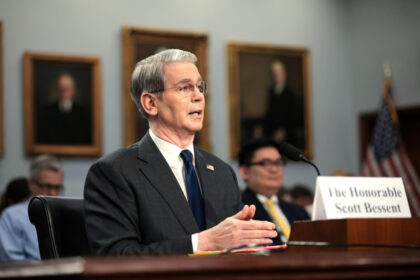“Together we will safeguard the bright prospects of our Asian family,” Chinese President Xi Jinping pledged during his visit to Malaysia last week. In the midst of the ongoing China-U.S. trade war, Xi is being proactive in his regional engagement with China’s neighbors. Travelling to Southeast Asian nations that have been hard-hit by U.S. tariffs. Xi unveiled his vision of an “Asian family.”
The new phase of U.S. President Donald Trump’s trade war started with imposing tariffs on steel, aluminum, and automobiles, and later expanded with his “reciprocal tariffs.” On April 2, dubbed “Liberation Day” by the White House, Trump imposed what he called reciprocal tariffs (in actual fact, the rate seems to be based exclusively on the trade deficit, not on a country’s tariff rates) on almost every country in the world – ranging from a baseline rate of 10 percent to 49 percent tariffs on Cambodia. As China retaliated by also raising tariff rates on U.S. goods, Trump imposed more tariffs on Chinese imports, eventually reaching 145 percent. However, amid a stock market meltdown and growing complaints from Trump’s billionaire friends, he paused the universal tariff, leaving only the 10 percent baseline tariff on all countries except China.
Deep uncertainty remains, as Trump has said the “pause” on the reciprocal tariffs would only last for 90 days, and relief beyond that was contingent on each government negotiating a trade deal with the United States. Under the tariffs outlined on April 2, Southeast Asian countries were among the most impacted: Vietnam (46 percent), Cambodia (49 percent) and Malaysia (24 percent). It’s no coincidence that these were the three countries Xi visited during his first trip abroad of 2025.
These economies are mostly dependent on exports to the U.S. In 2024, Vietnam’s exports to the U.S. totaled $136.6 billion, representing 34 percent of its total exports and 30 percent of its GDP. Malaysia’s exports to the U.S. totaled $52.5 billion, accounting for 16 percent of its exports and 12 percent of its GDP. Cambodia exported $9.9 billion worth of goods to the United States in 2024, accounting for 38 percent of Cambodia’s total goods exports. These Southeast Asian emerging economic powerhouses are heavily reliant on their exports – especially exports to the United States – for their GDP. In the context and timing of Xi’s visits to Vietnam, Malaysia, and Cambodia from April 14 to 18 this holds significant importance.
While they primarily export their goods to the United States, these countries are also close economic partners of China, and Xi sought to capitalize on their mistreatment by the Trump administration. The Chinese leader’s message was simple: while the U.S. turns toward isolationism and imposes trade barriers, China offers partnership and open markets. Xi drove home his point by putting forth the “Asian family” concept.
During a meeting with Vietnamese Prime Minister Pham Minh Chinh, Xi underscored the deepening alignment between their nations. He specifically denounced trade wars in an op-ed published in Vietnam’s official media, saying, “Our two countries should resolutely safeguard the multilateral trading system, stable global industrial and supply chains, and open and cooperative international environment.” China and Vietnam signed 45 cooperation agreements covering infrastructure, digital trade, and cross-border development.
In Malaysia, Xi proposed a three-point plan to establish a high-level strategic China-Malaysia community with a shared future, and the “joint construction” of that “community” made its ways into the official joint statement. A total of 31 agreements were signed between China and Malaysia, including affirmations of China’s Global Security, Global Civilization, and Global Development Initiatives, along with deals on trade and industry cooperation, infrastructure projects, and technology collaboration.
Malaysian Prime Minister Anwar Ibrahim called Xi an “extraordinary leader” while stressing ASEAN’s commitment to multilateralism and free trade. The Belt and Road Initiative, which Anwar described as a “new lease on hope” was a key topic, with both sides seeking to collaborate on infrastructure, AI, and the green economy.
Xi’s visit to Cambodia, which has long been aligned with Beijing economically and politically, similarly brought a raft of new deals. Some 37 agreements were inked in sectors ranging from investment and trade to education and youth affairs, plus a funding deal on the Funan Techo Canal.
During his tour of Southeast Asia, Xi presented China’s vision for the region, emphasizing unity against external confrontation and safeguarding its prospects. He reiterated his opposition to hegemonism and foreign interference, urging regional solidarity against external pressures. In response to the U.S. push for strategic decoupling, China asserts that this approach negatively impacts China’s interests and poses a threat to the stability of the Asian economy.
Southeast Asia, China’s primary trading partner bloc and a crucial component of its supply chain, holds significant strategic importance amid the growing China-U.S. trade war. The diverse region encompasses countries with pro-China attitudes, treaty allies of the United States, and neutral nations. ASEAN has thus emerged as a testing ground for Xi Jinping’s “Asian family” pitch, which emphasizes shared development over zero-sum competition.
China seeks to counter U.S. influence through economic carrots. As seen on Xi’s trip, China wants to emphasize its open market to neighboring nations, encouraging high-quality exports and cross-border infrastructure integration. The BRI also aims to enhance mobility and trade through rail links connecting Malaysia, Laos, and Thailand.
China is positioning itself as a steadfast partner advocating for multilateralism, open trade, and regional cooperation with the Southeast Asian region. Xi Jinping’s “Asian family” vision aims to connect with the region to erode U.S. influence in the region. In response to Washington’s evolving containment strategy, including potential secondary sanctions on countries that strengthen ties with Beijing – such as the countries that Xi just visited this week – Xi’s message serves as both a rebuttal and a counterproposal. The trade war has transcended borders, and China’s solution lies in redefining the economic landscape, with Southeast Asia as the frontline of this effort.






